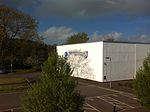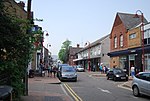New Hythe railway station
DfT Category F2 stationsFormer Southern Railway (UK) stationsKent railway station stubsRailway stations in Great Britain opened in 1929Railway stations in Kent ... and 3 more
Railway stations served by SoutheasternTonbridge and MallingUse British English from August 2015

New Hythe railway station is on the Medway Valley Line in Kent, England, serving the village of New Hythe. It is 38 miles 3 chains (61.2 km) down the line from London Charing Cross via Strood and is situated between Snodland and Aylesford. The station and all trains that serve the station are operated by Southeastern. The APTIS-equipped ticket office, in a 1930s building on the northbound platform, closed in September 1989 and subsequently became derelict. In 2007, a PERTIS (Permit to Travel) ticket machine was installed at the entrance to the northbound platform.
Excerpt from the Wikipedia article New Hythe railway station (License: CC BY-SA 3.0, Authors, Images).New Hythe railway station
Dry End Road, Tonbridge and Malling East Malling and Larkfield
Geographical coordinates (GPS) Address Nearby Places Show on map
Geographical coordinates (GPS)
| Latitude | Longitude |
|---|---|
| N 51.313 ° | E 0.455 ° |
Address
New Hythe
Dry End Road
ME20 6XJ Tonbridge and Malling, East Malling and Larkfield
England, United Kingdom
Open on Google Maps






